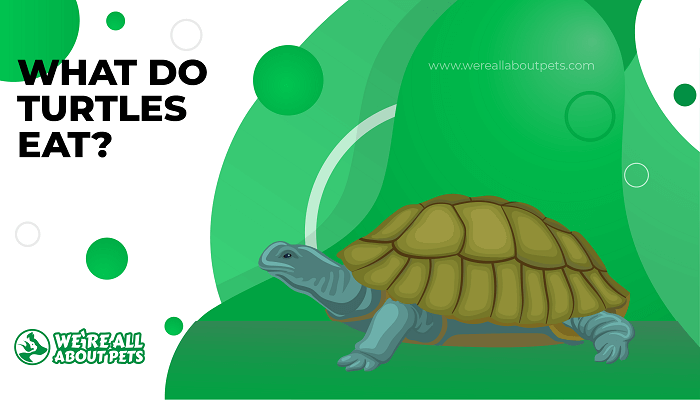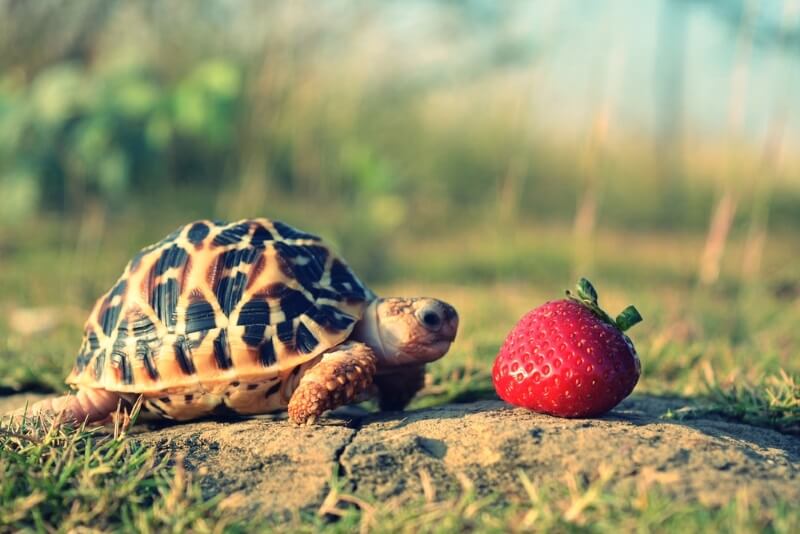What Do Turtles Eat?
This page contains affiliate links. We may earn money or products from the companies mentioned in this post through our independently chosen links, which earn us a commission. Learn More

Though they may not be your typical pet, turtles have many wonderful qualities. They’re relatively low maintenance, entertaining to watch, and they’re completely unique from other pets.
The thing you need to remember, however, is that they have specific nutritional needs that must be met.
There are many different turtle species that are kept for pets, including red-eared sliders, box turtles, painted turtles, and softshell turtles.
Other species, like snapping turtles and sea turtles, are not typically kept as pets, though their nutritional needs may be similar to those of a pet turtle’s diet in some cases.
What your turtle eats will determine his long-term health and wellness, so make sure to do your research. Finding the right diet for your species of turtle is a must.
Read on to learn the basics about foods that are and are not safe for turtles, along with some general feeding recommendations, but be sure to research further on specific animals you’re keeping. There are some differences among species.
Quick Navigation
Safe and Unsafe Foods for Turtles
Before you feed your pet turtle anything, you need to make sure that the food is safe for your turtle to eat. Turtles have different nutritional requirements than those of other pets, so you can’t assume that just because it’s safe for one animal it’s safe for another. Lucky for you, we’ve assembled a list of dozens of foods that are and are not safe for pet turtles.
Foods That Are Safe for Turtles:
- Commercial turtle pellets
- Small fish (but not in excess)
- Crickets
- Mealworms
- Waxworms
- Earthworms
- Slugs
- Beetles
- Dandelion greens
- Romaine lettuce
- Squash
- Zucchini
- Green beans
- Kale
- Carrots
Foods That Turtles Can Eat in Moderation:
- Boiled egg
- Cooked chicken
- Cooked shrimp
- Berries
- Grapes
- Melon
- Kiwi
- Mango
- Pumpkin
- Papaya
- Sweet potato
Foods That Are Not Recommended for Turtles:
- Milk
- Yogurt
- Cheese
- Raw meat
- Processed foods
- Bread
- Corn
- Grains
- Dog food
- Cat food
Foods That Are Toxic or Harmful for Turtles:
- Iceberg lettuce
- Celery
- Rhubarb
- Beets
- Beans
- Mushrooms
- Peas
- Turnips
- Tomatoes
- Brussels sprouts
- Onions
- Peppers
Foods That Can Be Offered as Rare Treats
- Spinach
- Collard greens
- Radishes
- Cabbage
- Broccoli
When it comes to choosing what to feed your turtle, you have to keep in mind his nutritional needs.
For example, leafy greens like romaine lettuce and dandelion greens are nutritious options, but iceberg lettuce provides little to no nutritional value. Veggies like cabbage and brussels sprouts have higher oxalates and may cause bladder stones if fed in excess. Onions and peppers can be toxic.
Types of Turtle Diets
In the wild, most turtles are omnivores. They’ll eat a wide range of foods, including small insects, crustaceans, fish, and vegetation.
A wild turtle’s diet depends largely on its natural habitat and the available food sources. For example, land turtles may eat an entirely different diet than freshwater turtles and sea turtles.
When it comes to formulating your pet turtle’s diet, think about what wild turtles of the same species would eat and do your best to mimic that diet.
Here is a quick breakdown of the different components of a pet turtle’s diet:
- Commercial Turtle Food – Turtle pellets are formulated to provide the right blend of protein, fat, and other nutrients that your turtle needs. They should make up about 25-50% of his diet, with the rest coming from whole foods like insects or feeder fish and fresh fruits and vegetables.
- Insects – Insects like crickets, mealworms, and earthworms should make up about 25% of your turtle’s diet. Feed a variety because different insects have different nutritional makeups. The insects should always be fed healthy vegetables before being offered and they should be dusted with a calcium supplement.
- Feeder Fish – Small goldfish and other feeder fish can be a valuable source of protein. However, many small fish have an enzyme that breaks down Vitamin B, so feeding too many can be bad for your turtle.
- Vegetables – Leafy greens with high nutrient content, like kale and mustard greens, can be offered daily or several times a week. Land turtles tend to eat more vegetation than aquatic turtles do. Rinse the vegetables thoroughly with water to remove chemicals, or use organic vegetables.
Also Read: The 5 Best Turtle Foods
You can supplement your turtle’s diet with fresh fruits and aquatic plants like water hyacinth and duckweed. Use fruits only as treats. They’re high in simple sugars and will cause digestive issues if fed too much.
Meeting Your Turtle’s Nutritional Needs
The appropriate diet for a pet turtle depends on the type of turtle. Aquatic turtles are closer to being carnivores, though they are still classified as omnivores because they eat vegetation as well.
Some land turtles are herbivores, but box turtles still fall into the omnivore category.
As previously mentioned, your turtle’s diet should consist of about 25-50% commercial turtle food, with the rest being split between protein food sources like insects or small fish and fresh foods like leafy greens and aquatic veggies.
Baby turtles require the same foods, just in a slightly different concentration. For example, your baby turtle will need to eat a greater proportion of insects and feeder fish to meet his growing bodies’ protein requirements. Turtle pellets should still be offered so that your baby turtle gets used to eating them. Vitamin supplements should be offered twice a week and calcium supplements should always be on the insects. Many turtles also need pre-formed vitamin A in the supplement because they can’t metabolize beta-carotene. Look for that in the supplement or turtle pellet.
This may be true more for baby aquatic turtles like red-eared sliders than for baby land turtles. Baby box turtles, for example, tend to be true omnivores. Feed these turtles a more even blend of protein and vegetation.
Remember that your turtle needs essential vitamins and minerals like calcium as well. When feeding live insects, gut-load them first by feeding them healthy foods so the nutrients will be passed along to your turtle.
Young turtles should be fed every day, while adult turtles can be fed every 2-3 days.
To give you an idea of what turtles eat and much you should be feeding your pet turtle in different life stages, refer to this chart:
| Daily Turtle Feeding Chart | ||||
| Age | Size | Commercial Food | Protein | Fruits and Veggies |
| Up to 12 months | Baby Box Turtle | Small amounts of commercial turtle pellets | 50% insects and feeder fish* | 50% leafy green veggies with occasional small amounts of fruit |
| 1 year and up | Adult Box Turtle | 25-50% of total diet | 25% insects and feeder fish* | 25-50% leafy green veggies with occasional small amounts of fruit |
| Up to 12 months | Baby Aquatic Turtle | Small amounts of commercial turtle pellets | 75% insects and feeder fish* | 25% leafy green veggies with occasional small amounts of fruit |
| 1 year and up | Adult Aquatic Turtles | 25-50% of total diet | 25% insects and feeder fish* | 25% leafy green veggies with occasional small amounts of fruit |
*be careful in the selection of fish, and avoid ones that contain thiaminase. This enzyme breaks down vitamin B- goldfish, fathead minnow and any frozen-thawed fish
Aquatic turtles need to eat their food in the water.
In addition to providing the right types of food to your turtle, think about water as well. Aquatic turtles will typically drink from the water they swim in, but land turtles may require a water dish. Keep the water in your turtle’s tank clean to keep your turtle safe.
Recommended Commercial Turtle Foods
To make sure your pet turtle gets the right blend of nutrients in his diet, provide commercial turtle pellets in addition to insects, feeder fish, and fresh foods. Look for a recipe made with high-quality, natural ingredients that contain plenty of protein and calcium. Avoid products that contain too many artificial additives like colors, flavors, and preservatives because these don’t provide any nutritional benefit for your turtle. Pay attention as well to the unique needs of different species of turtle.
The ideal commercial turtle food is about 40-45% protein and 6-10% fat.
Here are some of our top picks for the best commercial turtle food:
- Tetra ReptoMin Floating Food Sticks – Made with protein-rich fish meal and shrimp meal, these floating food sticks are an ideal choice for aquatic turtles. In addition to plenty of protein, they are fortified with vitamin C and calcium.
- Fluker’s Aquatic Turtle Diet – Available in 4-ounce and 8-ounce packages, this floating turtle diet is designed for aquatic turtles. These pellets are made with a premium blend of proteins and enriched with essential vitamins to deliver complete and balanced nutrition.
- Rep-Cal Maintenance Formula Box Turtle Food – Made with natural plant and fruit ingredients, this recipe is formulated specifically for box turtles to ensure proper growth and health. It can be fed dry or moistened with water or fruit juice.
Looking for more recommendations on what to feed your turtle?
Check out our in-depth guide to the best commercial turtle foods.
Turtle Feeding FAQs
What do turtles eat in the wild?
A wild turtle’s diet depends on the species. Most tortoises are strict herbivores while most turtles are omnivores. Aquatic turtles and box turtles feed on small fish, crustaceans, and insects, along with various types of vegetation. Freshwater turtles are entirely different from sea turtles. The leatherback sea turtle feeds primarily on jellyfish while the green sea turtle is herbivorous, eating mostly seagrass.
How much do turtles eat?
The amount your turtle eats depends on its age and species. Generally speaking, baby turtles should be fed once a day while young adult turtles can be fed every other day. Older turtles may need to be fed only every two or three days, with edible plants in the tank available for snacking.
What do turtles drink?
Turtles drink water like any other animal. Aquatic turtles tend to drink the water they swim in, while land turtles may require a water dish. Regardless of the water source, the water should be kept clean to keep your turtle healthy.
Do turtles eat insects?
Yes, most pet turtles are omnivores and feed on a combination of protein food sources (e.g., feeder fish and insects) and fresh vegetation.








